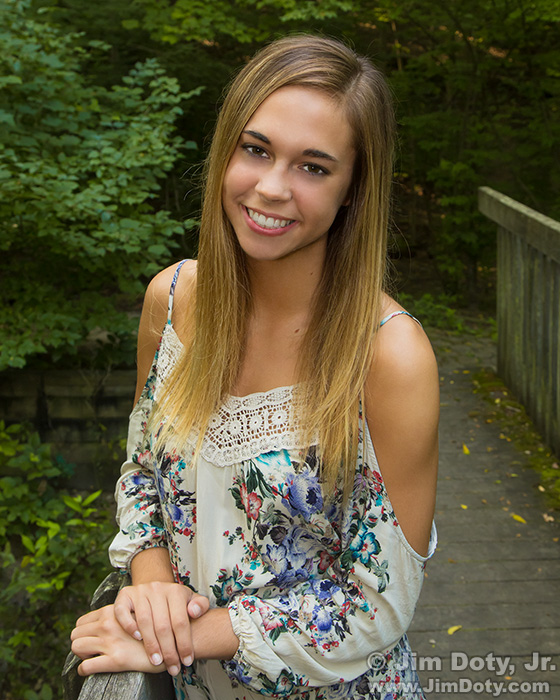Cloudy bright days are great for portrait photography. No harsh shadows. Soft even, flattering light. So what do you do in the harsh light (at least for most portrait photography) of a bright, sunny day?
Find some place in the shade. In this case, the shade provided by the trees that surround this bridge. Shade often means cool, bluish light so you will need to set the white balance on your camera to “shade”, or do a custom white balance, or correct the white balance later using software. Adobe Camera Raw is a great software option for color correction (link below) and it comes free with Adobe Photoshop Elements, Adobe Lightroom, and Adobe Photoshop.
Metering for skin tones is easy. Pick an area of skin big enough to meter (like the face or a bare shoulder) and make sure your camera meter sees nothing but skin. For a person with light skin tones, add plus one stop (+1) of exposure compensation and you will get nice, light skin tones. For a person with dark skin tones, subtract one stop (-1) of exposure compensation and you will get nice, dark skin tones. If your subject has medium skin tones, don’t make any changes to the metering. Once you have metered the skin and made any necessary compensation to the exposure, lock in that exposure setting or the camera will re-meter the scene and mess up the exposure. The simplest way to do this is in manual exposure mode. In the case of this photo, if the camera had been on auto exposure it would have picked up on the dark background, changed the exposure and washed out Kristin’s face.
The eye sockets may look a bit dark in the shade so you can lighten them with a bit of fill flash which has the added benefit of creating a catch light in the eyes. In a situation like this I usually set the flash exposure compensation (which is totally separate from the ambient light exposure) to about minus 1 1/3 to minus 1 2/3. You don’t want the flash to be obvious or overwhelm the subject.
When you photograph someone it is nice to give them something to do with their hands. The bridge provides something to hold on to or to lean against.
Photo Data: Canon 5D Mark III. Canon EF24-105mm f/4L IS USM lens at 40 mm. 1/60 sec, f/9, ISO 800. Canon EX 550 flash. Flash exposure compensation set to – 1 1/3.
Links
If you want to learn a lot more about the qualities of light, metering, exposure compensation, manual and automatic flash, flash exposure compensation, portrait photography, and a whole lot more, read my book, Digital Photography Exposure for Dummies. It is one of the highest rated photography books at Amazon. Learn how this book will transform your photography and order it at Amazon.com.
Color Correction with Adobe Camera Raw
Excellent “How To Photograph People†Books

